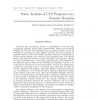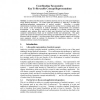48 search results - page 3 / 10 » Achieving Flexibility In Unification Formalisms |
SAS
1992
Springer
14 years 1 months ago
1992
Springer
Abstract Constraint logic programming (CLP) is a generalization of the pure logic programming paradigm, having similar model-theoretic, fixpoint and operational semantics [9]. Sinc...
AIME
1995
Springer
14 years 1 months ago
1995
Springer
: A unified controlled medical vocabulary has been cited as one of the grand challenges facing Medical Informatics. We would restate this challenge as ‘achieving a re-usable and ...
APN
2006
Springer
14 years 1 months ago
2006
Springer
We consider nested nets, i.e. Petri nets in which tokens can be Petri nets themselves. We study value semantics of nested nets rather than reference semantics, and apply nested ne...
IJAR
2000
13 years 9 months ago
2000
Multiply sectioned Bayesian networks (MSBNs) provide a coherent and flexible formalism for representing uncertain knowledge in large domains. Global consistency among subnets in a...
ICDE
2007
IEEE
14 years 4 months ago
2007
IEEE
The correct implementation of security protocols is a challenging task. To achieve a high degree of confidence in an implementation, as with any software, ideally one requires bot...


